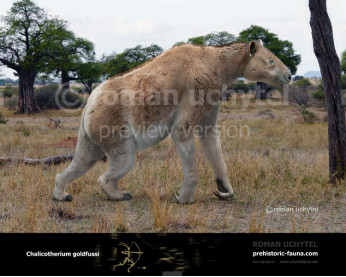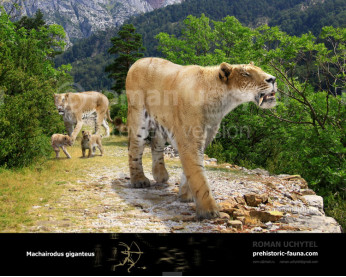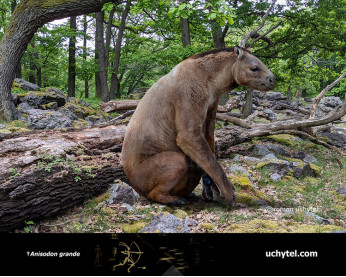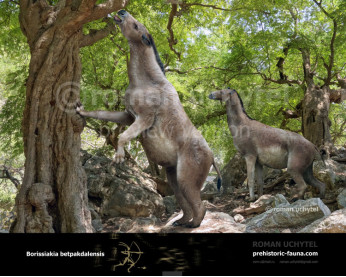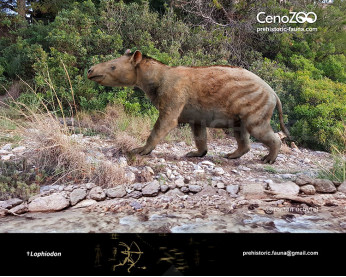Ancylotherium
24422442
Ancylotherium (†Ancylotherium (Gaudry, 1863))
Order: Perissodactyla
Superfamily: †Chalicotherioidea
Family: Chalicotheriidae
Subfamily: †Schizotheriinae
Time period: That lived during the Late Miocene-Early Pleistocene of Europe, Asia, and Africa (9.0—1.8 mya)
Size: 4 m in length, 180-200 cm in height, 300-500 kg of weight
Ancylotherium was relatively large, and was built rather like a takin, with some individuals reaching 2 metres high at the shoulder and a weight of 450 kilograms. While it had the typical long forelimbs and short hind limbs of a chalicothere, like other schizotheriines, it did not walk on its knuckles. It was similar to the North American genus Moropus. Ancylotherium had the highest-crowned teeth of any chalicothere, suggesting a diet of more abrasive plants. While this has been reconstructed as leaves, twigs, and tree bark, one skull discovered in China was from a dry steppe zone with few trees; the genus may have been less dependent on browsing leaves than other chalicotheres.
Ancylotherium's habitat was the savannahs of Eurasia, East and South Africa. As a herbivore, it evolved to browse on vegetation on the trees in the grassy savannahs of Africa. Ancylotherium's closest relatives are the other perissodactyls, or "odd-toed" ungulates, including the extinct brontotheres and modern-day mammals such as horses, tapirs, and rhinoceroses.
Оплата
У Вас є кілька зручних способів купівлі зображення: кредитна чи дебетова картка Visa, Mastercard, Maestro; PayPal або банківський переказ
Ancylotherium (†Ancylotherium (Gaudry, 1863))
Order: Perissodactyla
Superfamily: †Chalicotherioidea
Family: Chalicotheriidae
Subfamily: †Schizotheriinae
Time period: That lived during the Late Miocene-Early Pleistocene of Europe, Asia, and Africa (9.0—1.8 mya)
Size: 4 m in length, 180-200 cm in height, 300-500 kg of weight
Ancylotherium was relatively large, and was built rather like a takin, with some individuals reaching 2 metres high at the shoulder and a weight of 450 kilograms. While it had the typical long forelimbs and short hind limbs of a chalicothere, like other schizotheriines, it did not walk on its knuckles. It was similar to the North American genus Moropus. Ancylotherium had the highest-crowned teeth of any chalicothere, suggesting a diet of more abrasive plants. While this has been reconstructed as leaves, twigs, and tree bark, one skull discovered in China was from a dry steppe zone with few trees; the genus may have been less dependent on browsing leaves than other chalicotheres.
Ancylotherium's habitat was the savannahs of Eurasia, East and South Africa. As a herbivore, it evolved to browse on vegetation on the trees in the grassy savannahs of Africa. Ancylotherium's closest relatives are the other perissodactyls, or "odd-toed" ungulates, including the extinct brontotheres and modern-day mammals such as horses, tapirs, and rhinoceroses.

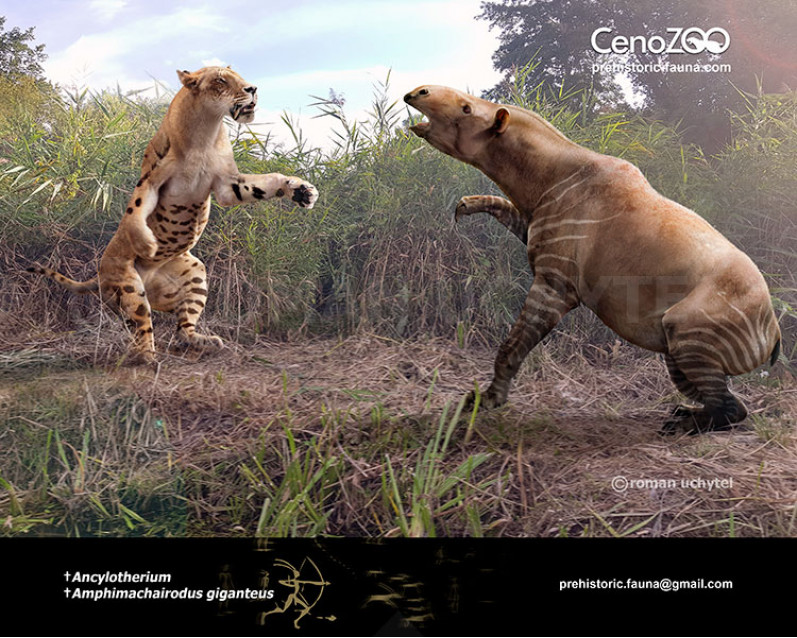
-797x638.jpg)

-70x56.jpg)
